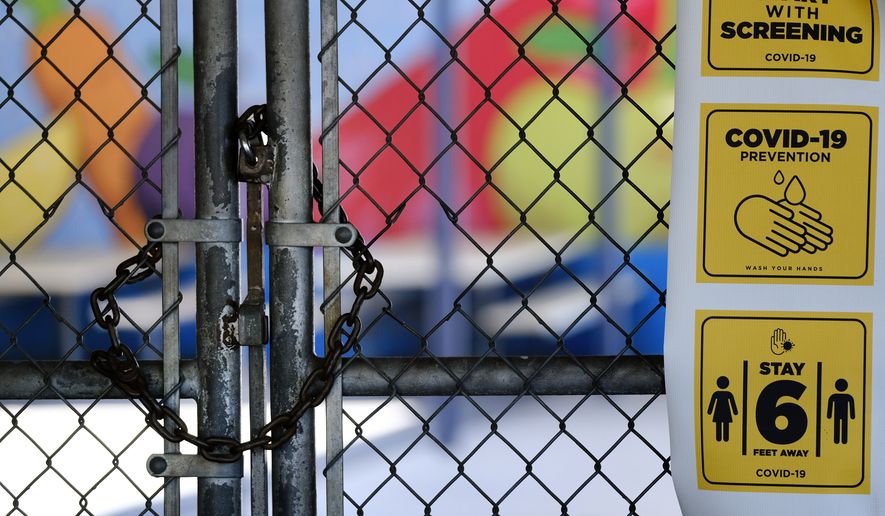Just $6 billion of the nearly $130 billion earmarked for K-12 schools in President Biden’s coronavirus relief package is slated to go out the door before October, according to Congress’ official budget scorekeeper.
And most of the $113 billion for schools from previous relief packages hasn’t been spent yet.
The projections lend credence to the notion that the $1.9 trillion relief package Congress is rushing to pass needs to be better targeted, particularly the spending to reopen schools.
“Congress has already appropriated almost $68 billion for K-12 COVID relief, much of which remains unspent,” said John Schilling, president of the American Federation for Children. “It is long past time for Congress to bypass the public school bureaucracies and provide funding directly to families.”
The piles of unspent money only intensify the frustration of parents fed up over the Biden administration’s mixed messaging on getting children out of a seemingly unending quarantine and back into classrooms.
White House press secretary Jen Psaki insisted Thursday that schools still need more funding to safely reopen.
“We are working with Congress to get additional funding, which is essential to many school districts across the country,” she told reporters.
Of the $129 billion House Democrats included for K-12 schools in their proposed package, $6.4 billion is projected to go out in the current budget year and $32 billion would be distributed in both fiscal 2022 and 2023, according to the Congressional Budget Office. The rest would be spent through 2028.
The bill includes $170 billion for K-12 and colleges. Congress previously authorized about $113 billion for education in COVID-19 relief packages lawmakers approved last year.
“Because most of those funds remain to be spent, CBO anticipates that the bulk of spending of funds provided in the reconciliation recommendations would occur after 2021,” CBO said.
Senate Republicans estimated that of the $68 billion Congress authorized last year for K-12 schools, just $4 billion had been spent.
The White House did not respond to questions about the CBO projections. An administration official told Fox News that they wouldn’t allocate the funding based on CBO numbers and that they anticipated the funds would be used more quickly.
Critics of the $1.9 trillion proposal say it spends too much money and spends it frivolously.
Rep. Andy Biggs, chairman of the conservative House Freedom Caucus, said the administration and congressional Democrats are readying a package “that will continue to shut children out of schools and exacerbate our debt and deficit.”
“The reckless spending package will not help reopen our economy or our schools; it will compound the issues that have been worsening since bureaucrats first hijacked our freedoms and schools last March,” the Arizona Republican told The Washington Times. “We must do what is right for our children and their future, not for school unions and special interests.”
Mr. Biden said he wants most K-8 schools reopened for in-person learning within 100 days of his taking office.
The White House also waffled about what would qualify as reopening, walking back a suggestion that the benchmark could be as little as one day per week of in-person learning.
The mixed messaging has frustrated parents, many of whom are dealing with kids relegated to almost a full year of virtual learning.
“Talk about moving the goalposts. One hundred days for us doesn’t really mean anything because by the time 100 days would happen, the kids would be nearly out for the summer anyway,” said Candice Dartez, 46, a mom with two daughters who have been attending school remotely in Laguna Beach, California, for nearly a year.
What she is hearing from Mr. Biden on school reopenings is confusing double-talk, she said.
“I don’t believe anything he says and I really don’t understand what he’s trying to accomplish, actually,” Ms. Dartez said. “It’s like the 100 days really applies to primary students and not secondary students, and once a week and no one really believes anything anyone says.”
Ms. Dartez is an independent voter who doesn’t consider herself overly political and didn’t vote in last year’s presidential election.
Republicans and conservatives sensed an opening. They said Mr. Biden and his teacher union allies are constantly inventing new hurdles to jump over before schools can reopen.
House Minority Whip Steve Scalise of Louisiana and several other House Republicans hosted a call with hundreds of parents on Thursday to talk about reopening schools.
The conservative advocacy groups State Government Leadership Foundation (SGLF) and N2 America launched a six-figure TV and digital ad campaign targeting Michigan, New Jersey, North Carolina and Virginia.
“The CDC, the science, and the experts say schools can safely open,” a narrator says in a 30-second spot as images of empty classrooms play in the background. “The failures won’t go unnoticed, because what’s happening is real. It’s time to let kids learn.”
Ms. Psaki said Thursday she hasn’t seen polling to suggest that blaming Mr. Biden for the schools issue is working.
“The president, the vice president and this White House don’t see reopening schools through a political prism,” she said. “We want to do it safely and the president is committed to reopening schools five days a week as quickly as possible.”
A Quinnipiac University poll released this week presented a mixed picture.
Forty-two percent of U.S. adults said they approve of how the Biden administration is handling school reopenings, compared to 38% who said they disapprove and 20% who weren’t sure.
A little less than half — 47% — said school reopenings in their community were happening at about the right pace, compared to 27% who said they weren’t going quickly enough and 18% who said they were moving too quickly.
• S.A. Miller can be reached at smiller@washingtontimes.com.
• David Sherfinski can be reached at dsherfinski@washingtontimes.com.




Please read our comment policy before commenting.